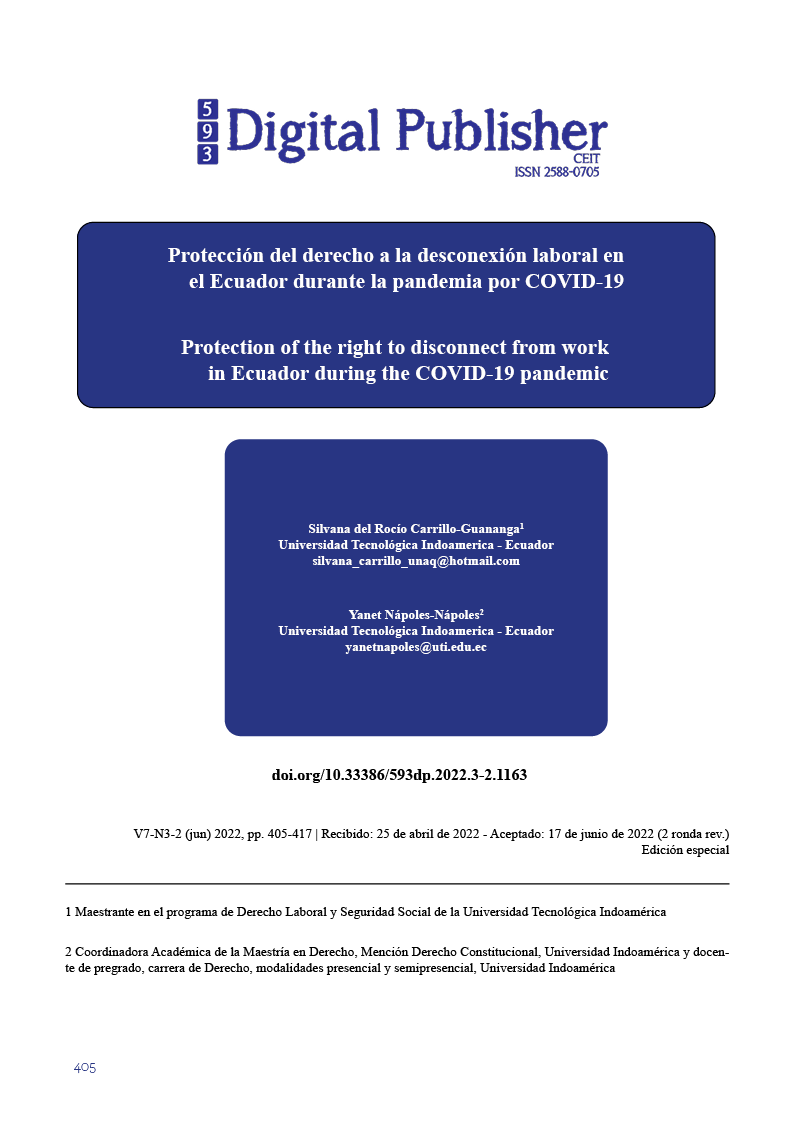Protección del derecho a la desconexión laboral en el Ecuador durante la pandemia por COVID-19
Contenido principal del artículo
Resumen
El presente artículo titulado “Protección del derecho a la desconexión laboral en el Ecuador durante la Pandemia por COVID-19”, pretendió analizar cómo el ordenamiento jurídico ecuatoriano garantiza al servidor público teletrabajador el cumplimiento del derecho a la desconexión. A primera vista se puede colegir que debido al uso desmedido de las nuevas tecnologías de la información y la comunicación (TIC) durante el periodo de pandemia por COVID-19, los empleadores han tenido mucha injerencia en la vida privada de sus trabajadores. Ello ha conllevado a que se generen alteraciones en las relaciones familiares y sociales, ya que en la mayoría de los casos los teletrabajadores no disponen de los tiempos de recuperación y de descanso a los cuales tienen derecho. Por lo que, resulta de gran importancia el desarrollo de esta investigación en la cual se analiza un tema actual y de relevancia en el ámbito jurídico laboral. Los principales puntos de análisis fueron: 1- Origen y evolución del trabajo; 2- Concepto de teletrabajo; 3-Elementos del teletrabajo; 4- El teletrabajo en la legislación ecuatoriana; 5- La jornada máxima de trabajo; 6- Derecho a la desconexión y 7. Derecho a la desconexión laboral en torno a la pandemia por COVID-19 en Ecuador. La metodología empleada fue la cualitativa, la cual permitió a través de la revisión bibliográfica y la observación, captar las cualidades y características esenciales del fenómeno para la mejor comprensión del tema.
Descargas
Detalles del artículo

Esta obra está bajo una licencia internacional Creative Commons Atribución-NoComercial-CompartirIgual 4.0.
1. Derechos de autor
Las obras que se publican en 593 Digital Publisher CEIT están sujetas a los siguientes términos:
1.1. 593 Digital Publisher CEIT, conserva los derechos patrimoniales (copyright) de las obras publicadas, favorece y permite la reutilización de las mismas bajo la licencia Licencia Creative Commons 4.0 de Reconocimiento-NoComercial-CompartirIgual 4.0, por lo cual se pueden copiar, usar, difundir, transmitir y exponer públicamente, siempre que:
1.1.a. Se cite la autoría y fuente original de su publicación (revista, editorial, URL).
1.1.b. No se usen para fines comerciales u onerosos.
1.1.c. Se mencione la existencia y especificaciones de esta licencia de uso.
Citas
Alles, M. A. (2020). Gestionar sin estar. Ediciones Granica.
Arrieta, F. J. (2019). La desconexión digital y el registro de la jornada diaria en España como mecanismos para garantizar el descanso, la salud y el bienestar de los trabajadores digitales a distancia. Lan Harremanak - Revista de Relaciones Laborales, 42, 89-126. https://doi.org/10.1387/lan-harremanak.21286
Acuerdo Ministerial. [MDT.] (2020, 12 de marzo). Acuerdo Ministerial Nro. MDT-2020-076. https://www.trabajo.gob.ec/wp-content/uploads/2020/03/ACUERDO-MDT-2020-076-TELETRABAJO.pdf?x42051
Acuerdo Ministerial [MDT.] (2020, 15 de marzo). Acuerdo Ministerial Nro. MDT-2020-077. https://www.trabajo.gob.ec/wp-content/uploads/downloads/2020/03/Acuerdo-MDT-202-077.pdf?x42051
Acuerdo Ministerial. [MDT.] (2020, 14 de septiembre). Acuerdo Ministerial Nro. MDT-2020-181. https://www.trabajo.gob.ec/wp-content/uploads/2020/09/AM-MDT-2020-181-TELETRABAJO-14.09.2020-signed.pdf?x42051
Acuerdo Ministerial [MDT.] (2022, 10 de marzo). Acuerdo Ministerial Nro. MDT-2022-035.https://www.trabajo.gob.ec/wp-content/uploads/2022/03/Acuerdo-Ministerial-Nro.-035-Norma-tecnica-para-regular-el-teletrabajo-en-el-sector-publico.pdf?x42051
Baz, J. (2021). Los nuevos derechos digitales laborales de las personas trabajadoras en España: Vigilancia tecnificada, teletrabajo, inteligencia artificial, Big Data.
Bottos, A. V. (2008). Teletrabajo: Su protección en el derecho laboral. http://site.ebrary.com/id/10398532
Buira, J. (2014). El teletrabajo: entre el mito y la realidad https://lectura.unebook.es/viewer/9788490296332
Código de Trabajo [CT.] (2005), Reforma (2020, 22 de junio). https://loyal.finder.lexis.com.ec/WebTools/LexisFinder/DocumentVisualizer/FullDocumentVisualizerHTML.aspx?id=LABORAL-CODIGO_DEL_TRABAJO
Constitución de la República de Ecuador [Const.] (2008, 20 de octubre). https://loyal.finder.lexis.com.ec/WebTools/LexisFinder/DocumentVisualizer/FullDocumentVisualizerHTML.aspx?id=PUBLICO CONSTITUCION_DE_LA_REPUBLICA_DEL_ECUADOR
Ferreyra, C., & Ocampo, C. V. (2020). El derecho a la desconexión digital. El teletrabajo: Una necesidad. Revista de Estudio de Derecho Laboral y Derecho Procesal Laboral │Universidad Blas Pascal, 2. https://doi.org/10.37767/2683-8761(2020)010
Ley Orgánica de Apoyo Humanitario [LOAH.] (2020, 22 de junio). https://loyal.finder.lexis.com.ec/WebTools/LexisFinder/DocumentVisualizer/FullDocumentVisualizerHTML.aspx?id=LABORAL-LEY_ORGANICA_DE_APOYO_HUMANITARIO
Ley Orgánica 3/2018, Protección de datos personales y garantía de los derechos digitales, (2018, 05 de diciembre). https://www.boe.es/eli/es/lo/2018/12/05/3
Llamosas, A. (2015). Relaciones laborales y nuevas tecnologías de la información y de la comunicación. Dykinson. http://vlex.com/source/relaciones-laborales-y-nuevas-tecnologias-de-la-informacion-y-de-la-comunicacion-una-relacion-fructifera-no-exenta-de-dificultades-14343
Martín, P. (2018). Teletrabajo y comercio electrónico. http://www.digitaliapublishing.com/a/60357/
Organización Internacional del Trabajo (2020) El teletrabajo durante la pandemia de COVID-19 y después de ella. https://www.ilo.org/wcmsp5/groups/public/---ed_protect/---protrav/---travail/documents/publication/wcms_758007.pdf
Pérez, F. (2019). Derecho de los trabajadores a la desconexión digital: Mail on holiday. REVISTA IUS, 14(45). https://doi.org/10.35487/rius.v14i45.2020.636
Sagardoy, I. (2021). Puntos críticos en relación al teletrabajo (tras el RDL 28/2020, de 22 de septiembre). Dykinson.
Sierra, E. M. (2011). El Contenido de la relación laboral en el teletrabajo. Junta de Andalucía. Consejo Económico y Social de Andalucía.



